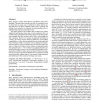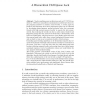MICRO
2010
IEEE
13 years 10 months ago
2010
IEEE
Abstract--Many shared-memory parallel systems use lockbased synchronization mechanisms to provide mutual exclusion or reader-writer access to memory locations. Software locks are i...
WDAG
2010
Springer
13 years 11 months ago
2010
Springer
We argue that traditional synchronization objects, such as locks, conditions, and atomic/volatile variables, should be defined in terms of transactions, rather than the other way ...
RTS
2010
13 years 11 months ago
2010
Reader preference, writer preference, and task-fair reader-writer locks are shown to cause undue blocking in multiprocessor real-time systems. Phase-fair reader writer locks, a ne...
PPOPP
2010
ACM
13 years 11 months ago
2010
ACM
Many programs exploit shared-memory parallelism using multithreading. Threaded codes typically use locks to coordinate access to shared data. In many cases, contention for locks r...
ASPLOS
2008
ACM
14 years 2 months ago
2008
ACM
Standard concurrency control mechanisms offer a trade-off: Transactional memory approaches maximize concurrency, but suffer high overheads and cost for retrying in the case of act...
EUROPAR
2006
Springer
14 years 4 months ago
2006
Springer
Abstract. Modern multiprocessor architectures such as CC-NUMA machines or CMPs have nonuniform communication architectures that render programs sensitive to memory access locality....
HIPC
2005
Springer
14 years 6 months ago
2005
Springer
Abstract. The proliferation of multiprocessor servers and multithreaded applications has increased the demand for high-performance synchronization. Traditional scheduler-based lock...



